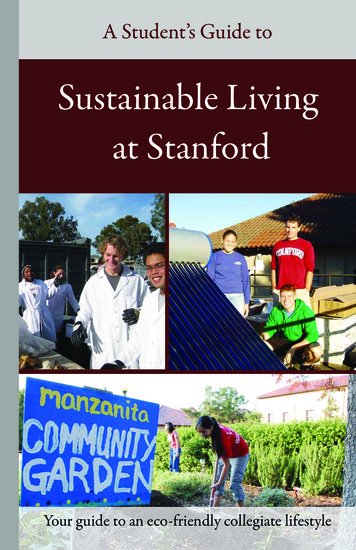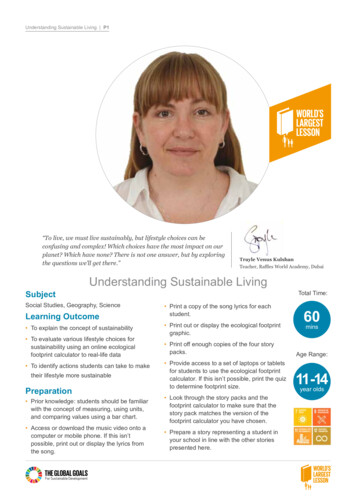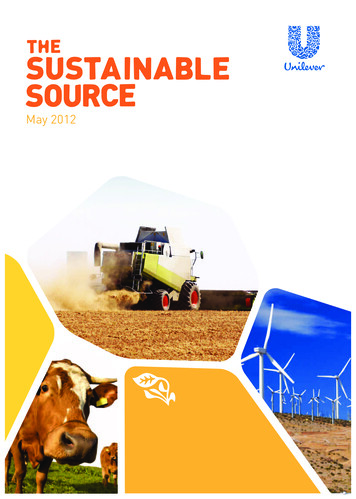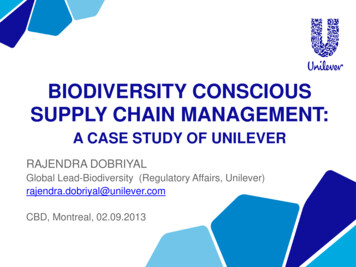
Transcription
A Student’s Guide toSustainable Livingat StanfordYour guide to an eco-friendly collegiate lifestyle
Welcome to Sustainable Stanford!“Setting an example is not the main means ofinfluencing others; it is the only means.”—Albert EinsteinWelcome to Stanford—a campus that cares deeply aboutresponsible and environmentally sustainable resource use.We believe sustainability means meeting the needs for today in aresponsible fashion that does not compromise the ability to meetthe needs of our future.Stanford researchers are uncovering policy and technologicalsolutions to climate change, greener buildings, and renewable energy. Stanford staff members lead by example and use environmentalsustainability as a criterion for all aspects of university operations.Certified as a green business in 2004, Stanford has been in the highest tier for overall leadership in sustainability in North Americain 2007, 2009 and 2010 (See http://greenreportcard.org/). Aswe continue to seek innovative and lasting solutions to reduce ourenvironmental footprint, we invite you, the most important stakeholder, to be an active part of that journey.This guide has been created by your fellow students with help fromcampus staff to provide you with some easy tips for an eco-friendlylifestyle on campus. The actions your friends share as they welcomeyou to campus greatly complement the efforts underway by administration and staff. In this guide you will see examples of specificaccomplishments in campus sustainability, and things you can dodeepen their impacts. Not every aspect is included in this booklet,and with your help we will enrich the content every year.With your enthusiasm, support, and creativity, we look forward togetting even closer to achieving a shared vision-—a truly sustainableStanford University; your learning environment for the next fourmomentous years.Stanford Office of SustainabilityOffice hours: every Monday 3:30- 5:30 PM340 Bonair Siding,Stanford, CA 94305Visit us at http://sustainable.stanford.edu
ContentsWelcome to Sustainable Stanford!. . . . . . . . . . . . . . . . . Inside front coverWhy Go Green?. . . . . . . . . . . . . . . . . . . . . . . . . . . . . . . . . . . . . . . . 4Sustainability Starts at Home. . . . . . . . . . . . . . . . . . . . . . . . . . . . . . . 6Working Hard or Hardly Working? . . . . . . . . . . . . . . . . . . . . . . . . . .10Zero In On Waste. . . . . . . . . . . . . . . . . . . . . . . . . . . . . . . . . . . . . . 14Eating Green. . . . . . . . . . . . . . . . . . . . . . . . . . . . . . . . . . . . . . . . . 16Sustainability must become a core value in everything we do. As a community we are committed to developing our core campus in a sustainablefashion that preserves what we cherish, that demonstrates leadership inthe university’s commitment to be a good environmental steward and thatsafeguards the ability for future generations to thrive at Stanford.”-John Hennessy, President, Stanford UniversityGetting Around the Green Way . . . . . . . . . . . . . . . . . . . . . . . . . . . . 20Shopping With an Environmental Conscience. . . . . . . . . . . . . . . . . . 24Learn More and Stay Connected . . . . . . . . . . . . . . . . . . . . . . . . . . . .26Sustainability Pledge. . . . . . . . . . . . . . . . . . . . . . . . . . . . . . . . . . . . 28Acknowledgements. . . . . . . . . . . . . . . . . . . . . . . . . . Inside back cover
Why Go Green?aThe Reason Your Choices MatterWhen you become a part of the Stanford community, you are joiningan academic institution dedicated to being a model for environmentalstewardship.Knowing where your energy and water come from is the first step inunderstanding your environmental impact and ways to reduce it.Read on to learn where Stanford gets its resources.Water Stanford’s drinking water comesfrom the San Francisco PublicUtilities Commission, which drawsits water primarily from the HetchHetchy Reservoir near Yosemite. Stanford’s irrigation water comesfrom surface water diverted fromcreeks on Stanford property in thefoothills and from wells on campus.Quick Tips:How much is a pound ofCO2? Imagine CO2 trappedin a balloon. A pound ofCO2 would make a balloon that3was 8 ft . With 44 lbs CO2 emit‐ted by each of us daily, imagineeveryone on campus walking3around with a 350‐ft balloonbobbing above our heads!Electricity Most of Stanford’s electricity isproduced on campus at the Cardinal Cogeneration power plant, whichcreates electricity from natural gas and chilled water for cooling. Thesteam waste heat from electricity generation is used to heat campusbuildings. 4The local utility, Pacific Gas and Electric (PG&E), buys back excessenergy from the Cogen plant.Reasons to Go Green1. It’s Easy, and It Adds UpYour daily decisions affect the environment in small ways that addup to make a large impact. In the same way, small individual dailychoices can make a big difference.2. It’s Good For YouActions that are healthy for the environment are often healthy foryou too! Consider all the extra exercise you get by biking or walking instead of driving.3. It Saves You MoneyUsing less costs you less. For example, buying a fluorescent lightbulb instead of an incandescent one can save you more than 30 over the life of the bulb.4. It Saves Our PlanetAs the world’s population continues to grow, each of us needs to bemore conscious of our use in order to provide for future generations.Our environmental choices are especially important as residents ofCalifornia, a state that will face impacts of climate change, and atrendsetter for the world.5. Your Campus Needs YouYour campus encourages you to work with the various sustainabilityprograms to continue to keep this campus an environmentallysustainable one.What can you do? Read on!5
Sustainability Starts at HomeaWays to be Green Around the HouseYour house, room, or apartment is the easiest place to begin making apositive impact. Read on for simple ways to reduce your home’swater and energy usage—and convince your peers to make eco-friendlychanges while you’re at it.Staying Cool or Warming Up: If you are using air conditioning or heating, make sure that yourwindows are tightly shut. If you’re too hot while the heater is running,turn it off (if you can). Opening the window will only cause the heaterto work harder, making your room even hotter. At Home: In Your RoomLighting:Study in the daylight whenever you can! If you need light during theday, open up your shades before flipping the light switch. If you bring any of your own lamps to school, be sure to buy compactfluorescent bulbs (CFLs). These not only use 75% less energy thanconventional bulbs, but last 10 times longer and are much cheaper tooperate. It may seem obvious, but don’t forget to turn off the lights when youleave your room.If your room is too cool for your comfort, opening the shade while thesun is out will warm up your room. When the sun goes down, closethe shades for extra insulation. On the other hand, if your room istoo warm, keep the windows and shades closed during the hot day tokeep the heat out, then open them during the cool night to lower yourroom’s temperature.Do You Really Need Your Own Refrigerator? If you think you might wanta fridge, wait to consult withyour roommate. You maywant to share one. If you dobuy a fridge, select an EnergyStar model. Instead of purchasing a newfridge that you will probablyneed to resell at the end ofyour four years, consider renting one. Better yet, all on-campushouses have a house fridgelocated in the kitchenettethat you can use for free. Justremember to label your food.Student studying under natural daylight to save energy67
At Home: In the BathroomAt Home: Doing LaundryShowering Shorten your shower. Every minute less you spend in the shower savesup to two gallons of water. Think also about lowering your waterpressure using the sliding handle on many showers and using less hotwater—a cool shower feels great after one ofStanford’s hot sunny days.Using the Washing Machines Only do laundry if you have full loads. If you don’t have enough laundry for a full load, combine loads with your roommate. Not only willyou conserve water and energy, but you will also be saving a trip to thelaundry room. Consider washing with cold water under the “bright colors” setting.Saving Water Utilize the dual-flush function available onmany school toilets to reduce water usage—remember to check the low flush direction. Use greener laundry detergents that are plant-based and free of phosphates. Also remember to recycle your used laundry detergent bottle. If a shirt is not stained or smelly, why throw it in the laundry bin? Foldit up and put it back in the drawer. Don’t worry, no one’s watching. Contrary to popular belief, there’s no reason to separate your whitesand colors unless you’re washing in hot water. Just choose the brightcolors setting and toss it all in there.Turn off the faucet while you arebrushing your teeth and doing dishes—peoplehave probably been telling you this since youwere five, but this is just a friendly reminder. If you see a leaky faucet, let Housing know byfiling a fixit request http://fixit.stanford.edu. Remember to recycle your used shampoo, conditioner, hair spray, andspray gel bottles.Drying Buy a hand towel to dry your hands in the bathroom. Usingdisposable paper towels is wasteful; a hand towel is way morecomfy anyway. If you must use paper towels, try to take a smallerpiece—you’ll be amazed at how it still gets your hands just as dry!Lighting Turn off the lights when you leave the bathroom if no one else is there.Many bathrooms have multiple light switches, so try to only turn onone at night. In addition, many bathrooms have separate lights for theshower stalls—don’t forget to turn these off too when you’re on yourway out.8What About Drying? Stanford has a lot of sunny warm days—perfect for drying your clothes outsideor on a clothesline. If your house doesn’thave a clothesline, contact Housing to letthem know you prefer line drying!Stanford Fact:Water conservation effortshave reduced daily domesticwater use from 2.7 million gal‐lons per day ( mgd) to 2.1 mgdsince 2001. If it’s necessary for you to use a dryer, note thatthe dryers are much larger than the washers at Stanford.You can easily combine multiple wash loads in one drying cycle. Evenif you need to run the dryer for an extra 15 minutes to accommodatethose extra clothes, it will still use less energy and time than running awhole separate drying load. When using the dryer, set it on the lowest time cycle that you thinkit will take for your clothes to dry. If you come back and they’re stilldamp, you can always just put them in for another couple minutes.9
Working Hard or Hardly Working?adollars at a local store such as Walgreens, rather than buying new ones.Eco-Friendly Homework and Computing TipsLet’s face it: Stanford students work. A lot. But it turns out that thereare quite a few ways to make your work environment more eco-friendlyand perhaps increase your productivity at the same time!Studying Take advantage of Stanford’s beautiful sunny weather by studying undernatural daylight. Study outside, or ifyou prefer to not get sunburned, studyin your room with the lights off and thewindow shades wide open. Save all the scratch paper you can getStudent studying outdoorsyour hands on—you’ll need a lot of it when it comes time to dopractice problems for exams.Printing10 Despite having only 5% of the world’s population, the U.S. uses 30%of the world’s paper. Do your part to drive that number down. Whenpossible, submit papers and assignments electronically. If you do needto print something, always print double-sided or on the back of scratchpaper. Try to print in “economy” mode; this savesink and is usually just as legible as the morewasteful ink settings. Preview your documents to eliminate excesswhite space and dangling sentences. Makesure you’re not printing any more pages thannecessary. If you bring your own printer to school, besure to refill your ink cartridges for a fewQuick Tips:If your printer doesn’tautomatically printdouble‐sided, don’tdespair! Print only theodd‐numbered pages,then put them back inthe paper tray upsidedown and print theeven‐numbered pageson the other side. If you do need to get rid of an old ink cartridge, recycle it! To learnhow, see the recycling section.Smart Strips: Good For You and the Planet Buy a Smart Strip. Your room will likely not have enough outletsfor all of your electronics. A smart power stripincreases the number of outlets, providessurge protection, and eliminates electricity wasted from phantom loads (as long asyou remember to turn the strip off whenyou are not using it). Smart Strips are aQuick Tips:specific type of power strip thatWhat is a phantom orvampire load? Manycan sense when your computer goes toelectronics use smallsleep or is turned off, and will automatiamounts of energy evencally turn off power to your computingwhen they are turned off.peripherals (such as your printer andAcross the U.S., 6% of ourscanner) to protect you from phantomannual energy costs comefrom these “phantom”loads. Smart Strips are also great for TVenergy loads. To counterand audio equipment. They are availablethis, unplug your electron‐at the student-run Green Store or online atics when you aren’t usingpopular retail websites. To learn more visit them, or plug them intohttp://sustainable.stanford.edu/a Smart Strip so they areturned off automatically.sustainable IT.ComputingStanford Fact: Put your computer to sleep! Set your powerInstalling Stanford’s “Big Fix”settings to turn your monitor off after fivepower management tool onminutes of inactivity, and put your computer24,000 campus computers willsave an estimated 400,000 per to sleep after 10, reducing your computer’syear, as well as reduce campusenergy usage by about 95%. Better yet, shutcarbon emissions by 28,000yourcomputer off when you don’t need ittons of CO2/year.instead of leaving it on 24/7.11
Turn off your screensaver. We love your fancy graphics and funpictures, but those screen savers typically use more energy than justrunning your computer. Set your screensaver to ‘blank’, or better yetset your monitor to turn off. Once off, your monitor will turn onagain as soon as you move the mouse or hit a key.Need a new computer? To minimize your environmental impact, buya laptop rather than a desktop computer, get a flat screen monitor ifyou need one, and be sure what you buy has the best EPEAT ratingavailable. All Stanford-recommended computers are EPEAT Gold,and you can get them at a great discount. What’s EPEAT?It is a joint effort between the Environmental Protection Agency(EPA) and the hardware manufacturers that measures and reports ontheenvironmental impact of computers and monitors, focusing onmanufacturing, packaging, usage, and recyclability. Learn moreabout select models at www.epeat.net.In Class Green your note-taking: try taking notes electronically on your laptop(they’re much harder to lose)! If you need to buy notebooks, look fornotebooks and other school supplies made from recycled materials.100% post-consumer content for paper is best.If you like to take notes on the lecture handouts, don’t print them! Youcan take notes electronically on PDFs of lecture slides with programslike Microsoft OneNote or Adobe Acrobat (available throughhttp:// ess.stanford.edu).Quick Tips:Ever wonder if you should turn off your computer or keep it on all night?Definitely turn it off. The small surge in power to boot up a computer issignificantly less than the energy needed to keep it running all night. Turning itoff won’t damage the computer, and in fact, it does some good by resetting thesystem and clearing out caches.12How Much Energy Do Your Computer andPeripherals Use?Watts used while tandby3153Hibernate2Off211MonitorsAwake/Active Sleep/Standby Hibernate17” LCD FlatPanel Monitor353017” CRT Monitor8020Office PrintersPrintingReadySleepLaser BW, InkjetPrinter380100Laser Color Printer400350PeripheralsAwake/Active Sleep/Standby ntingStandbyPower SaveNetwork BW LaserPrinter550277Off00Off00Off3Off1Network ColorLaser Printer4451870Network Copier16002901204Network Copier/Printer17003301559Source: Sustainable IT initiative in Sustainable Stanford13
Zero In On Wastea The Many Ways to Recycle on CampusStanford makes recyclingeffortless. Producing newproducts is energy, water, andresource intensive. Recycling replacesvirgin material production and significantly reduces energy consumptionand greenhouse gas emissions. Casein point: recycling just one aluminumcan saves enough energy to run a TVfor three hours! Every student roomcomes equipped with a blue recyclingbin—use it. Recycle printer cartridges, toner, cellphones, CDs, and consumer electronicdevices in electronic waste bins, foundin the housing front desks of largerresidences or in different academicbuildings around dCansPaperProductsReusablesOrganicsElectronics recycling binOtherBy weight, only 26% of items thrown into thegarbage are actual trash. The rest could berecycled, reused, or composted. Where to Recycle What: Recycle all paper, plastic bags, bubble wrap,and air pillows together inside the paperrecycling bins.Bottle and can recycling bin Recycle all glass bottles, aluminum cans,aluminum foil, tin cans, plastics bottles#1-7, Plastic #1 PETE & #2 HDPE, milk/juice cartons and boxes, and soymilk containers inside the bottle and can recyclingbins. Recycle all corrugated cardboard inthe green dumpsters. Recycle batteries in the batteryrecycling bin, usually found in yourhall’s computer cluster.Cardboard recycling dumpster14 Recycle larger electronic items such ascomputers and televisions by bringingthem to 339 Bonair Siding, CampusRecycling Center.Other items recycled on campus at Peninsula Sanitary Service, Inc.’s (PSSI) Operations Yard: construction and demolitiondebris, pallets, scrap wood, and scrapmetal.Don’t forget to reuse old items beforeeven sending them to the recycling center.Printrough drafts on the back ofscratch paper or see ifothers in your houseStudent awareness projectStanford Fact:want to read a magazineIn 2009, Stanford’sbefore you recycle it. For larger items you nowaste diversion ratelonger need but others may want, post them onwas 65%.networking sites like freecycle.org or Craigslistbefore sending them to the recycling center orlandfill. Recycle clothing and textbooks at http://techtain.comTO LEARN MORE : Visit http://recycling.stanford.edu.15
Eating Green(and enjoying your food more!)a Sustainable Dining on Campus and BeyondThink about what you ate yesterday. Where did it come from? Whomade it? What chemicals were used in its production? In an ideal world,you would know the answer to all those questions, but chances are you cananswer one at most. How food isproduced and distributed impactsyour health, the health and livelihoods of farmers, farm workers,animals, and our natural resources.Stanford is aspiring to be a leaderin changing our country’s foodsystem to one that is healthy, community-based, environmentallyRicker Dining’s organic garden provides herbssound, humane, and fair.and vegetables for the dining hall Stanford Dining purchases grass-fedbeef, organic milk, sustainably-caughtseafood, local and organic produce,and more! The campus Community Farm andcommunity herb-and-vegetablegardens provide organic produce todining halls and sell produce to campuscommunity members at a weekly farmstand. Dining puts on an annual “Eat Local” week and monthly “Eat Local”dinners featuring seasonal food. Often during these dinners,local farmers come into the dining halls to meet with students. All dining halls now have compost bins for food scraps.In 2009, Stanford composted 1,300 tons of food. 10,000 gallons of waste oil from the dining halls are converted tobiodiesel each year.What’s Happening in Dining? In 2008, Dining began a “LoveFood, Hate Waste” campaign tourge students to waste less foodand compost what is leftover ontheir plates.Stanford Dining aims to be a leader in sustainable food. Certified as a Green Businessin 2004, Stanford Dining has implemented avariety of programs to educate the communityand encourage sustainable food operationsStudent gardener LaurenPonisio with her harvest16Stanford Dining’s SustainabilityInitiatives 40% of Stanford Dining’s produce isorganic or locally grown; some is evengrown on campus at the CommunityFarm and at more than 10 student-run vegetable-and-herb gardens around campus.Student gardener, Mattias Lanas,at an “Eat Local” dinner Leftover usable food from thedining halls is donated to homeless shelters through the studentgroup SPOON, instead of goingto waste. Stanford’s “Dining in the Daylight” program leaves the lights in dininghalls off during the day to save energy and allow students to dine undernatural daylight.17
Actions You Can Take on CampusIn the Dining Halls Go trayless! Forgoing dining hall trayswill not only save on water used to cleanthem, but will also help keep you fromgrabbing too much food. (Make sure tocompost any leftovers you do have). Minimize your dishes. Try not to graba different plate for every food item youtake.Beyond the Dining Halls: Making Sustainable FoodChoices in the Real WorldStanfordFact:Best or Good Category of thePurchase Greener Foods Buy locally grown foods, directly if possible. Try to visit your localfarmer’s market or sign up for a Community Supported Agriculture(CSA), in which you receive a weekly box of seasonal produce.Seafood Watch Card and, in Buy organic. Organically grown foods are free of nasty herbicides andpesticides that are found on conventionally grown produce. Think about eating. Meat production is very energy and waterintensive. If you prefer, eliminate meat from a single meal each week.In 2008, 74% of StanfordDining’s seafood was in the2009, our goal is 100%. Vote with your fork! Choose sustainablefood options, including local, organic,grass-fed, antibiotic/hormone-free, cagefree, fair trade, and vegetarian/vegan. Make your voice heard! Ask questionsand give feedback to your chef andmanager about the food they offer.Grow Your Own Food There are many dining hall and housegardens on campus; become a student gardener or start your own!Students at Stanford’sCommunity Farm.18 Take the hands-on “Local Sustainable Agriculture” class at theCommunity Farm and learn sustainableQuick Tips:agriculture techniques while growingStanford has a produceorganic produce. Learn to cook. Live in a co-op or yourown apartment, ask to help out in thekitchen wherever you live, or participatein the Cardinal Cookoff sponsored byStanford Dining.stand at Tresidderevery Friday and at Mungerevery Tuesday from 11‐3during Spring, Summer,and Fall quarters. Drop byto purchase fresh,organic,seasonal, and locally grownproduce!Eat Well While Eating Out Reduce, reuse, and save money by bringing your own water bottle,mug, plastic ware, utensils, and bag when you’re going out.Some cafés provide discounts for bringing your own mug. Only order what you can eat or bring your leftovers homewith you to eat later. Ask about restaurants’ practices, andsupport businesses that share your ideals.Consider: Seasonal, organic purchasing Relationships with farmers Humane meat and dairy Sustainable seafood Fair trade products (i.e. coffee, tea,bananas, chocolate) Waste reduction efforts Labor standards for employeesQuick Tips:You can make adifference! Due to theinitiative of Stanfordstudents, most on‐campuseateries switched fromstyrofoam to compostableplates and utensils.TO LEARN MORE: Visit http://eatgreen.stanford.edu or contactsustainable food coordinator Matt Rothe at mrothe@stanford.edu orfarm educator Sarah Wiederkehr at swied@stanford.edu.19
Getting Around the Green Waya Reducing Your Transportation Impact on the EnvironmentThe Stanford campus and the Bay Area are home to many transportationoptions. Take advantage of them! Read on for tips about how to getaround, while minimizing your costs and your carbon footprint.Stanford’s Marguerite shuttle: TheMarguerite is FREE for students and thepublic, and is equipped with bicycle racks. The Marguerite provides weekdayservice to locations throughout campus,with connections to regional transit,dining, and shopping. There is also evening and weekendMarguerite shuttle busservice to the following off-campus destinations from September to June: StanfordShopping Center, Palo Alto Transit CenterStanford(Caltrain), and the San Antonio ShoppingFact:Center (Target, Safeway, Trader Joe’s, Whole Stanford offers morethan 12,000 bike rackFoods, Sears, etc).Getting Around: On CampusWalking: Stanford promotes safety for pedestrians by designating“Pedestrian Zones” across most of central campus, where vehicle accessis restricted.Biking: Biking is one of the fastest and most common methods of gettingaround campus. Wear a helmet for every ride, and follow the rules of theroad!20 Stanford is ranked as a gold-level“Bicycle Friendly Community”by the League of AmericanBicyclists. The Campus Bike Shop sellslocks, accessories, tools, tuneups, and rentals. Visitwww.campusbikeshop.com.Getting Around: Bay Area andBeyond!Outreach for BIke to Work Day Parking & Transportation Services (P&TS) hosts a bike informationbooth in White Plaza almost every Friday from 11 am–2 pm duringthe academic year. Drop by to register your bike and to get answers toyour biking questions. P&TS also provides bicycle safety workshopsand dorm roadshows, along with bike helmet discounts. Regional bike maps are available through P&TS. Visithttp://transportation.stanford.edu/bike to learn more. Bikes can also be taken on Marguerite shuttles, regional buses, and onCaltrain.spaces and 11.7 milesof bike lanes.Getting off campus is easier than you think. For information on getting topopular destinations near campus by bike or transit, check out “Thrivingat Stanford Without A Car,” available at http://transportation.stanford.edu/thriving.Here are public transportation options that you might want to use: Bicycle. Stanford offers resourcesfor bicyclists, including regional bikemaps, bike route planning, and bikesafety classes.Caltrain Caltrain runsbetween Gilroy and SanFrancisco. The Palo AltoCaltrain station is near the edge ofcampus. Visit www.caltrain.com formore information.21
VTA buses run throughout Santa ClaraCounty and south of campus to San Jose andSan Jose, with connecting service to SantaCruz and Monterey. Visit www.vta.org formore information.SamTrans buses run throughout San Mateocounty and north of campus to San Francisco. Visit www.samtrans.com for moreinformation.Quick Tips:Visithttp://transit.511.orgto have your Bay Areatrip planned for you.Just enter your startingand ending locations,and the program willdo the rest.BART runs from Millbrae (connecting withCaltrain) north throughout San Francisco and across the bay to Berkeley and Oakland and to the East Bay. Visit www.bart.gov for moreinformation.For more details about each of these transportation systems, as well asinformation on other public transit options, including the AltamontCommuter Express (ACE), Dumbarton Express, Line U StanfordExpress (free with Stanford ID), San Francisco Muni buses, ACTransit, and Capitol Corridor/Amtrak, visit : You Don’t Have to Own a Car!Zipcar is an on-demand car sharingprogram available 24/7 with 34 cars atfifteen Stanford locations. Visit zipcar.stanford.edu to learn more.Students utilizing one ofStanford’s 34 Zipcars22 Reserve online and pay as little as 7 an hour to drive a car(gas insurance included). Stanford faculty, staff, and students (age 18 and older) receive 35driving credit with a 35 Zipcar membership.Zimride is a carpooling program that canhelp you share a ride with Stanford affiliates. Find a ride to the grocery store, airport,and beyond, or offer to drive othersnext time you are headed out! Register or login instantly with your Facebook account at zimride.stanford.edu.Enterprise Rent-A-Car Enterprise’s campus location offersdiscounted rates for Stanford affiliatesand 10 weeknight rentals for Stanfordresidents (requires pre-registration). The campus Enterprise office rents tostudents ages 18 and older. Visit transportation.stanford.edu/enterprise.Stanford Fact:Stanford’s employeedrive-alone rate has beenreduced from 72 percent in2002 to 48 percent in 2010,and transit ridershiphas increased from8 to 25 percent.Stanford Commute Club If you live off campus and do not purchase a long-term Stanford parking permit, you can join the Commute Club and receive hundreds ofdollars a year in Clean Air Cash or Carpool Credit. Members also receive free hourly car rental vouchers, Zipcar drivingcredit, and enrollment in Stanford’s Emergency Ride Home Program. Visit mute Planning Assistance Parking & Transportation Services provides alternative transportation planning assistance for Stanford affiliates. For assistance, send anemail to commuteclub@stanford.edu.23
Shopping With anEnvironmental Consciencea Paper or Plastic? (Hint: The answer is reusable)Every product you buy comes with a carbon footprint—an amount ofcarbon emissions associated with its production and distribution. Inaddition, many products have impacts on other aspects of the environment, such as natural resources like water and trees. Here are some tipsfor reducing the environmental impact of your purchases.BEFORE You Buy, Ask Yourself: Do I really need it? (Reuse plastic containers to pack your lunch.) Can I upg
Sustainable Living at Stanford. . munity we are committed to developing our core campus in a sustainable . Stanford University. 4. 5 a The Reason Your Choices Matter When you become a part of the Stanford community, you are joining . an academic institution










